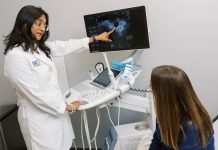One of the most frustrating things about being a parent is watching your child be in pain. We search for answers and a quick solution, but what happens when you can’t find one? What happens when the doctors don’t know what’s going on?

It took more than two and half years to receive a diagnosis of hypermobility for my son, Aiden. The orthopedic specialists focused on diagnosing and treating the individual pain episodes. We would walk away thinking the problem was solved, but then the pain would return – not always in the same place.
My son’s primary care pediatrician was persistent in helping us figure out what was happening. The recurring pain made her think it could be rheumatological, so she ordered blood work and referred us to a rheumatologist.
All of our previous visits with orthopedic specialists had been quite short – a quick exam and a look at x-rays, sonograms, or MRIs. The rheumatologist visit was much longer. He did an exam and then asked lots of questions. He used the Beighton Score to diagnose my son with hypermobility.
Hypermobility means his joints are able to move beyond the normal range. This is because of the connective tissues found within the joints. The collagen protein affects the way the ligaments and joints work. They are more flexible and looser than normal.
The Beighton Score looks at five different joints and evaluates whether you can perform certain tasks. The 9-point scale looks at the spine, elbows, knees, the knuckle of both little fingers, and the base of both thumbs. Take a look at the assessment tasks for hypermobility here.
For reference, Aiden scored an 8 out of 9. He is not able to bend over and place his hands on the floor with his knees straight.
We were eventually referred to a pediatric geneticist to evaluate Aiden for any Heritable Disorders of Connective Tissue, such as Ehlers-Danlos or Marfan syndrome. We had to fill out a lengthy family history before the appointment. The pediatric geneticist also performed an exam, found his Beighton Score, and asked questions. She determined Aiden had some connective tissue disorder – one that doesn’t exactly have a name.
This means there are a few general things we need to watch out for. The heart has connective tissue, so doctors recommend an echocardiogram to check for any abnormalities every five years until Aiden is an adult and then every ten years after that. The eyes have connective tissue, so we need to do regular vision screenings. Sometimes the skin and other organs can be affected, so we need to be mindful of any new symptoms.
Recurring muscle pain is the most common issue. The muscles have to work to stabilize the joints. This can make them fatigued and can cause pain. This is how hypermobility manifests for Aiden. Physical therapy and strengthening his muscles have been critical to Aiden’s care plan.
It has been four years since we started this journey and almost a year since we’ve seen the pediatric geneticist. He’s been in and out of physical therapy for the last two years. We now have a list of exercises and stretches to do at home to help keep his muscles strong. He still deals with bouts of pain. As he grows, his muscles have to readjust how they support his joints.
I asked Aiden for permission to share his story with you. We hope it offers encouragement to anyone in a similar situation.










